Internet marketers know that using Google AdWords is an excellent way to drive traffic to their sites. Since it can be expensive if not handled correctly, the trick is to manage campaigns to get the highest return on investment.
A poorly managed campaign can cost more than it brings in, but a well managed campaign can keep your store or company in business. It all comes down to how much you know about AdWords and how smartly you can manage your campaigns.
In this post, we’ll discuss the top 10 mistakes people make with Google AdWords. By avoiding these mistakes and following the alternative advice provided, you’ll be on your way to a highly successful AdWords campaign.
Mistake #1: Not Grouping Keywords Correctly
AdWords is set up so you can create campaign ad groups to manage different types of campaigns. (If you have a product campaign and a content campaign, each of them can be managed separately.) Within each campaign, you can break down your ads and keywords into ad groups.
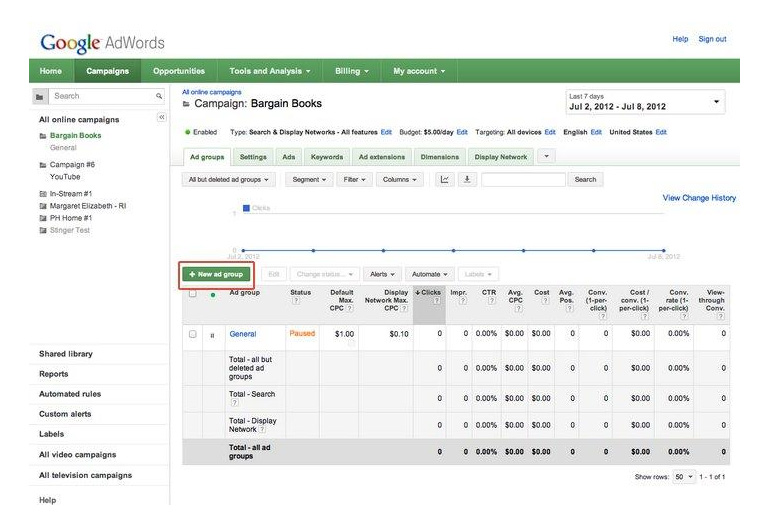
Click on the green “New ad group” button within a campaign to create new groups for your ads and keywords.
Not using ad groups is one of the biggest mistakes people make. Instead of segmenting their ads into groups based around similar types of keywords, they lump all of their keywords into one ad group and show everyone the same ad.
The problem with this approach is that PPC Management 101 tells us that the ad being shown should match the keyword being searched. The closer the ad copy matches the keyword, the more likely people are to click on the ad (and eventually order). Let’s look at an example.
Apple sells several different products. They sell laptops, desktops, tablets, and mp3 players. If they didn’t break up their products into different groups, then they wouldn’t be able to show specific ads based on what people are searching for. They would have to resort to an ad with a headline such as “Buy Apple Products” instead of an ad that matches what people are searching for.
Instead, Apple uses ad groups for each of their products so they can use headlines like “MacBook Pro” or “iPad Mini” when people search for those respective products.
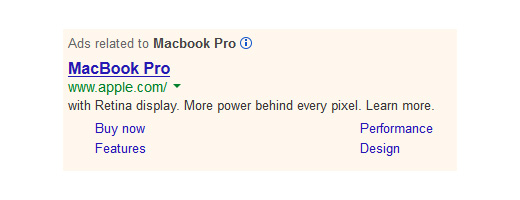
This is an example of an Apple ad from an ad group configured to show a MacBook Pro ad when people search for “macbook pro retina.”
If you don’t break up your keywords into different ad groups, then you’ll lump everything together underneath one ad copy. This doesn’t allow you to customize the ad to be a good fit for the term being searched for. The more you break up your ads and keywords into themes, the easier your campaigns will be to monitor and optimize.
Recommendation: The best rule of thumb is to use no more than 20 keywords per ad group. Sometimes you can get away with using a few more, but exceeding a 20 keyword limit is a sign that your ad copy isn’t matching the keyword being searched as closely as it could.
Mistake #2: Not Using the Right Keyword Matches
The next biggest mistake people make is not using the right broad match, phrase match, or exact match keywords.
Here’s how this works: AdWords allows you to add keywords to a campaign in one of the three ways mentioned above. You can add them as a broad match, phrase match, or exact match.
A broad match keyword means that your ads will show if the keywords are used in the search, regardless of the order. If you add “Nike running shoes,” for example, your ad will show up for people who type “Nike running shoes,” “Nike free running shoes,” and “where can I buy Nike shoes for running.”
A broad match means that your ad will show in a search so long as the keywords you entered show up in the search in one form or another. To enter a broad match term into AdWords, simply enter the term without any kind of punctuation before or after the term. In this example, you would simply type nike running shoes to add it as a broad match keyword.
A phrase match keyword means the keyword phrase needs to show up in the search as a complete phrase in the order you enter it. Using the same example as above, when you enter “Nike running shoes” as a phrase match keyword, then your ad will show up for terms like “Nike running shoes” and “where can I buy Nike running shoes.”
It will not show up for searches like “nike free running shoes” and “where can I buy Nike shoes for running” since the phrase doesn’t show up intact in those searches. In order to enter a keyword as a phrase match in AdWords, you enter it with quotation marks around the term when you add it as a keyword. Thus, with this example, you would type “nike running shoes” to add it as a phrase match keyword.
An exact match keyword works just like it sounds. The term being searched needs to exactly match the keyword that you entered in AdWords. Thus, if you have “Nike running shoes” as an exact match, it will show up only when someone searches for “Nike running shoes” and won’t show up even if someone searches for “Nike running shoes for sale.”
This may seem too narrow, but as you can imagine, it also makes your keywords and ads more precise. To add an exact match keyword in AdWords, you enter it with brackets around it like this: [nike running shoes].
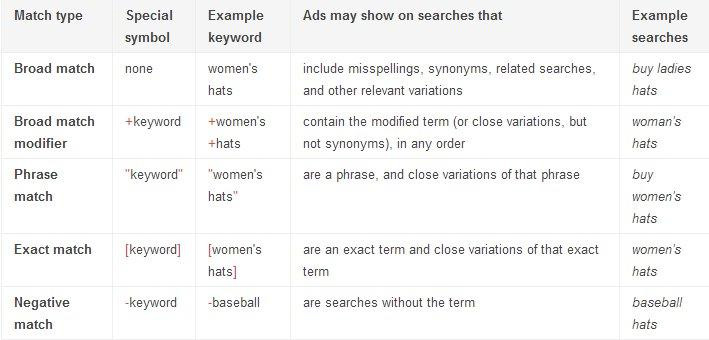
This match type chart is provided by Google at support.google.com. It shows broad, phrase, and exact matches as well as broad modifier and negative matches (which we’ll talk about more below).
So why does all of this matter? It matters because the type of match you use will have a big impact on your ads. A broad match will deliver more impressions, but it will be more imprecise since it will show up for terms that aren’t a tight fit for your products or the ad.
On the flip side, phrase and exact matches often provide a higher conversion rate, but they can deliver significantly fewer impressions, which means you may not reach as many people as you need to reach.
In some niches, the number of people looking for what you’re selling is low, so if you limit too much with exact matches, then you’re not going to get very much traffic. On the other hand, if you have too many broad match terms, then you may not get a high enough ROI on your ad campaign. The best scenario is to tweak your matches to find what works best for your business.
Recommendation: A good approach is to start with exact matches and then expand to phrase and broad as needed. If you aren’t getting enough impressions and conversions with exact matches, then you can add the terms as a phrase match and eventually as a broad match. On the flip side, if you aren’t getting good results with a broad match, you can scale back to use only exact and/or phrase matches.
Mistake #3: Not Using Negative Keywords
Another mistake people make is not using negative keywords. AdWords allows you to use negative keywords as a way to exclude keywords that are not a good match for your product.
For example, if you own an e-retail store that sells designer women’s shoes but not athletic shoes, then you won’t want your ads to show up on searches for “women’s running shoes” but do want them to show up on searches for “women’s shoes.” Thus, you can add “running” as a negative keyword, and your ads won’t be shown for any searches that include the word “running.”

Negative keywords are added by clicking “Negative keywords” underneath the list of keywords for your campaign or ad group.
Negative keywords can be added at both the campaign and the ad group level. Thus, if a word should be excluded from only one particular ad group, then you can exclude it at the group level, but if you want it excluded from the entire campaign, then you can do that as well.
Recommendation: In order to find words that should be excluded, you need to dig into Google Analytics since it has more detailed information than AdWords about specific keyword searches. Within Analytics, click on “Acquisition,” then “AdWords,” and then “Matched Search Queries.”
Next, click on “Query Match Type” and then either “broad match” or “phrase match” to view the exact keyword phrases people are searching for and which ones aren’t converting well. Once you find phrases that aren’t converting, take a look to see if a negative keyword can be added to eliminate that keyword from your campaign without excluding terms that are performing well.
Mistake #4: Not Trusting Numbers More than Your Creativity
Falling in love with your ad copy can be a problem. You may write some copy and think, “I love this ad!” That’s fine, unless the numbers tell you otherwise.
You should always be testing your copy. You can try two different headline variations, the same headlines but different body copy, or the same copy but a different call to action. Testing different variations will help you to know what works best. Sometimes mentioning a benefit will increase click-throughs and/or conversions. Other times, a different headline will improve your results. You’ll never know until you test.
And once you do start testing, don’t fall in love with any version of your copy. Once you have between 20 to 40 clicks, choose the one that’s getting the best results, which means the highest click-through rate, the highest conversion rate, or the lowest cost per acquisition (CPA), depending on what makes the most sense for your business. Don’t make the mistake of loving your clever copy more than the results you’re getting.
Recommendation: It’s recommended to always be testing. Once you have a winner for one test, turn off the loser, and change the ad copy again. Always try to beat the winner until you’re happy with the results. You may be surprised that this kind of testing can eventually lead to doubling your conversion rates and halving your cost per acquisition.
Mistake #5: Not Bidding on Your Own Brand
A lot of people make the mistake of not bidding on their own brand. They assume that since they already rank for their own brand, they don’t need to advertise for it. That’s one way to look at it.
Another way is to realize that if you aren’t advertising for your brand, other companies will. They’ll use your brand name for an ad group and target your visitors. Yes, you’ll rank first for the organic term, but your competitor may be advertising directly above that result.

In this example, Dell advertises for the search phrase “dell computer” even though they rank #1 for the search term.
Recommendation: In many cases, it makes sense to bid the highest for your own brand since people who are searching for your company are the most likely to convert. You want to make sure you’re at the very top for your own brand name, which means you can spend the most on branded terms.
Mistake #6: Not Knowing the Lifetime Value (LTV) of Customers
Have you ever calculated the LTV for your customers? If not, there’s no way to know how much you can spend on AdWords per acquisition.
Let’s say your LTV is $10. This means that you’ll earn $10 on average over the lifetime of doing business with your customers. If you’re paying $6 per acquisition, then you’re ok, because you’re making more per customer than you’re spending. But if your LTV is $4 and you’re spending $6 per acquisition, eventually you’ll go out of business.
Kissmetrics has an infographic titled “How to Calculate Lifetime Value – The Infographic.”
A lot of companies don’t know their LTV so they don’t know what a good CPA is. If customers stay with you an average of six months and pay $30 per month, then your LTV is $180. In this scenario, you’ll be doing ok even if your Google CPA is $100. It all depends on what you’re selling and what the LTV is for your business.
As an e-commerce business, you may lose money at the beginning, but make it back over the lifetime of doing business with your customer. Amazon likely knows how many people reorder and the average size per order. Based on that, they know how much they can pay per acquisition.
Recommendation: If you don’t know how to calculate your business’s LTV, then start with the How to Calculate Lifetime Value infographic from Kissmetrics. Calculate the LTV for your business, and then manage your campaigns accordingly.
Mistake #7: Not Testing the Optimal Ad Position
If your goal is to improve branding, then it’s a good idea to be in one of the top two ad positions, but if your goal is to get the best results, sometimes it’s better to be in position 3-5.
Can this really be true? Can it be possible that it’s better to be in a lower position than first or second? The answer is yes, and it’s because people tend to be click happy with the top two positions. They may click whether they’re seriously interested or not. But if your ad is in position 3-5 (or possibly lower), then it’s not the first thing people see.
People have to look at the side of their screen, which usually is something they do only after they’re not able to find what they’re looking for. Thus, being on the side acts as a filter. Only people who really are looking for a better result will click on your ad and visit your site.
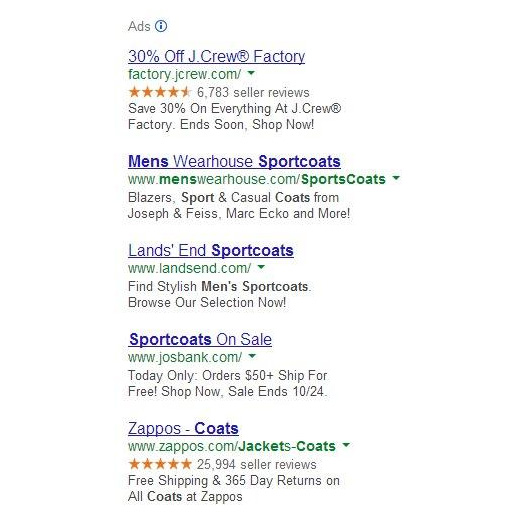
Often, being in the third position or lower in the right sidebar can lead to better results.
Without testing, there’s no way to know which ad position is the best for your business. Sometimes being in one of the top two positions works great, but other times, positions 3-4 provide a better return.
Recommendation: Test to find the optimal position by raising or lowering your bid on cost per click. Lower it and then see what happens. If Google suggests a $1 to $3 bid, start with $1 to see what the results are. If they’re good enough, you may not need to pay more per click.
Mistake #8: Not Knowing Who You’re Competing Against
Another mistake is not knowing which ads your competitors are using. You need to know who you’re competing against, what keywords they’re using, and what their landing pages look like.
Specifically, you want to put yourself in your customers’ shoes and see which ad you’re most likely to click on. Then, once you do click (although it’s recommended to find ways to do it without actually clicking on your competitors’ ads and making them pay for it), pay attention to their landing pages, and compare theirs with yours.

As seen in this example with Amazon.com, iSpionage makes it possible to ethically spy on your competition without making them pay for each click.
Which one is the most appealing? Which one would you rather go to if you were the customer? Take some notes and figure out what you can improve on your landing pages. Do you need a better design, a cleaner look and feel, security factors, testimonials, social proof, authority, or something else? Create a checklist based on the things you find.
Recommendation: First, scan your competitors’ ad copy to see what you can learn and apply. Then, scan their landing pages to see how you can improve your pages. Once that’s done, test new ad copy based on what you’ve learned, and then create new landing pages and test them against your old ones. Keep testing until you improve your conversion rates.
Mistake #9: Expecting Too Much from AdWords
Have you ever considered whether you expect too much from AdWords?
A lot of people have a really small budget and expect to launch the next big business with that tiny budget. They want to get in front of a large audience but have only $100 to $200 to spend per month. That’s not going to get you very far.
If your budget is too small, you won’t have enough to test your ads until they start performing well. Rarely does anyone nail a campaign right off the bat. It takes time to run and optimize your campaign to improve your return.
A small budget also means you’re going to burn through your campaign and will have to wait until more money is available. That gets frustrating. You’ll feel like, “This doesn’t work for me. I’m going to try something else.”
Recommendation: Start with a large enough budget that allows you to drive a significant amount of traffic and gives you time to tweak and optimize your campaigns. Make sure you also stick with the campaigns long enough to give them time to gain traction and to give yourself time to figure out how AdWords works and how you can get the highest return.
Mistake #10: (Specifically for E-commerce Businesses), Not Directing Visitors to the Appropriate Product or Category Page
Possibly, the biggest mistake of all that people make with AdWords is not directing customers to an appropriate product or category page. Instead, they direct everyone to their homepage.
Even if you have a pretty homepage, you don’t want to take people there directly, especially on e-commerce sites where you have category and product pages. It’s better to take people to a landing page or a product or category page where people will see a direct match to the ad they clicked.

It’s much better to direct people who search for “prom dress” to the prom dress page on DavidsBridal.com than it is to direct them to the homepage.
Recommendation: Make sure the page people land on matches the ad copy they clicked. For example, if you sell wedding related items, create ad groups based around themes like “bridesmaid gifts” and “groomsmen gifts.” Then take people to category pages for each of these items instead of to your landing page where they’ll have to click around to find the products they were interested in.
You also can test directing people to individual product pages that convert well. If you sell personalized bags that sell well, test an ad group that sends people directly to the product page, bypassing the homepage and the category pages.
Conclusions
Following the recommendations to avoid these top 10 mistakes people make with Google AdWords will help you optimize your campaigns and avoid the common pitfalls most people get stuck in with AdWords.
Do you have any questions after reading the article? Is there anything that stood out or that didn’t make sense? Ask a question or leave a comment so we can discuss!
About the Author: Leon Krishnayana is a founder and CEO at iSpionage.com, a competitive intelligence solution for digital marketers who are running Pay Per Click (PPC) and search engine optimization (SEO) campaigns. Follow Leon on Twitter,Facebook, or Google+.
Fonte: https://blog.kissmetrics.com/10-commons-adwords-mistakes/

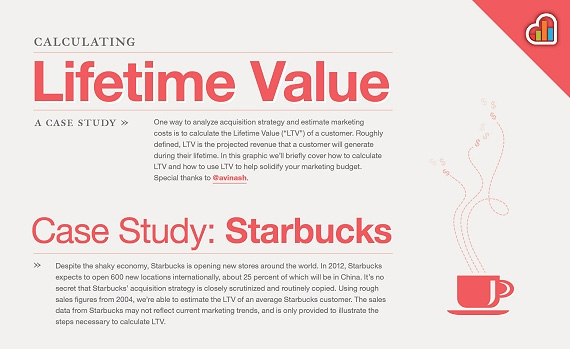

Sem comentários:
Enviar um comentário